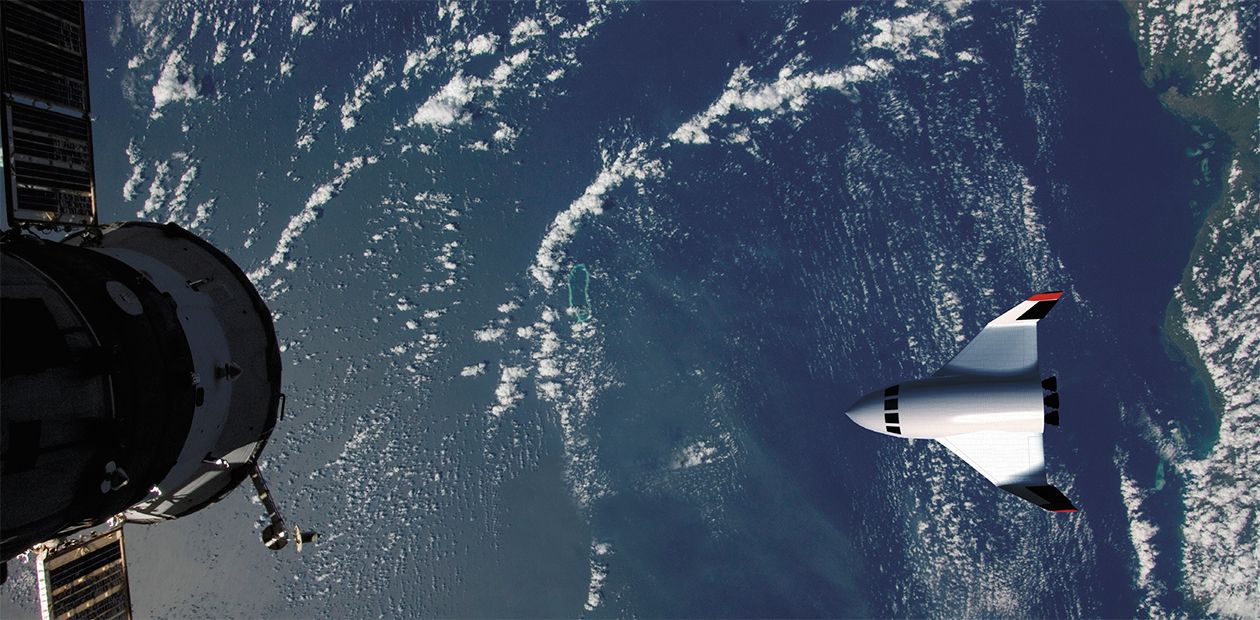Aerospace Transportation Systems of the Future
A powerful burst - and the rocket starts vertically from the launch pad and disappears high in the air… This is the picture we have been used to since the 1960s, which may soon become obsolete. Expendable space systems and shuttles will soon be replaced by a new generation of vehicles: aerospace planes, which will be capable of horizontal takeoff and landing, like usual airliners
It is commonly known that the Sun and other stars get their tremendous energy from the “thermonuclear furnace” burning in their depths. Nevertheless, the comparatively cold Earth also emits much more heat than it could be expected by considering some processes frequently encountered in nature, such as natural radioactive decay. Some scientists believe that the reason for this is the operation of a huge nuclear reactor deep in the Earth. This georeactor, however, is based on chain reactions of fission rather than on thermonuclear synthesis, as in stars
An incident happened in 1972 at a French factory producing enriched nuclear fuel. Until that time, the isotope composition of natural uranium was considered to be identical everywhere on the Earth. One lot of the raw material, however, contained a noticeably smaller amount of uranium-235 than usual. The Commissariat on Nuclear Energy started an investigation.
Specialists found that it was an impressive natural phenomenon rather than malice. It turned out that several areas of the uranium deposit in Oklo (Gabon) where this lot of uranium came from had experienced chain reactions of fission approximately 1.8 billion years ago. In other words, a real nuclear reactor operated at that time, and this reactor was made by nature rather than by humans! In particular, in studying the products of fission of one such reactor, it was found to operate during several hundred thousand years in the pulsed mode: with an operation cycle of half an hour and a pause of 2.5 hours, burning uranium-235.
URANIUM ISOTOPES AND CHAIN FISSION REACTION
Natural uranium mainly consists of a mixture of two isotopes: 238U and 235U (99.3 % and 0.7 %, respectively). The half-life periods are 4.5 billion years for uranium-238 and approximately 700 million years for uranium-235. Because of this large difference in the natural decay rate, the ratio of isotopes in nature changes with time: the fraction of lighter uranium-235 steadily decreases.238U and 235U are the parent elements for long radioactive series. For instance, uranium-235 decomposes first into thorium-234, which in its turn also decays. The final (stable) nuclides for natural chains of uranium decay are lead isotopes. The total amount of energy released in the entire chain of reactions is approximately 50 MeV.
The essence of a chain nuclear fission reaction is the fact that the nucleus of a radioactive element, for instance, uranium-235, captures a neutron, becomes unstable, and decomposes forming predominantly two large fragments and most importantly several neutrons. These neutrons can initiate fission of several other nuclei, thus initiating a chain reaction.
If more neutrons are newly formed than consumed in such an extended chain of reactions, the energy release increases in an avalanche manner. The energy released in one act of uranium fission is four times greater than the energy released owing to natural decay, and the energy release rate is extremely high. The most well-known examples of such processes are reactions in a nuclear bomb and atomic power plants.
Why is uranium-235 so important? The thing is that it is this isotope that is so easily fissionable under the action of slow neutrons, in contrast to the prevailing isotope, uranium-238, which can be fissionable by fast neutrons only (while fast neutrons become decelerated in a medium and the chain reaction decays before it starts).
Thus, billions of years before people arrived on the Earth, the nature had already mastered the technology that was still a mystery for the best brains of the planet in the middle of the last century.
The mere idea of a nuclear reactor in the Earth interior appeared approximately at the same time: it was almost 20 years before the discovery of the Oklo phenomenon! In 1953, American physicists G. Wetherill and M. Ingraham put forward a brave idea that chain nuclear reactions could have proceeded in deposits of radioactive elements, mainly uranium and thorium, in ancient times.
Dating these presumable processes to the era that was more than two billion years ago, the authors based their consideration on the concept that the fraction of the 235U isotope in the total amount of uranium was much higher in the middle of the Earth’s geological history than now and reached more than 3 %, as in the fuel of modern atomic power plants.
Scientists tried to find georeactors similar to the one in Oklo in other ancient deposits, but these attempts failed. Maybe the African reactor is a God’s joke, a result of random circumstances, and it is really unique? Even if this is so, scientists still suspect that nuclear fission reactions could have proceeded deep in the Earth’s interior many years ago and can take place now.
Telltale helium
Signs of operation of natural reactors are sought not only in the Earth’s crust, but also in the planetary interior. One reason for researchers’ persistence is the fact that the Earth emits approximately 2.5 times more heat than can be expected to result from natural decay of radioactive elements in the crust (radiogenic heat) and primary heating. (The thermal energy obtained from the Sun is not taken into account in this balance.) If an explanation for such a large difference is sought only in radiogenic heat from the planetary interior, the Earth on the whole should have unrealistically great resources of radioactive elements.
Chain nuclear reactions, however, release several times more heat than natural radioactive decay. The chain mechanism of energy release could explain the above-mentioned heat disbalance and many other unusual phenomena. If the hypothetical reactors are located deep inside the Earth, it becomes clear why their traces could not be found in uranium deposits (except for the Oklo deposit). Scientists were looking around, but maybe it is worth “digging deeper down”?
Thus, let us assume that such a reactor operates somewhere inside the Earth. What are the signs that allow one to find it? One possible method is to analyze the fission products migrating from the reaction zone and reaching the Earth’s surface. In particular, it is of interest to analyze the isotope composition of helium, which is sometimes called the “solar element.”
Natural helium consists of two stable isotopes: 4He and 3He. A part of helium-3 is entrained to the Earth’s atmosphere with the solar wind and via b-decomposition of tritium – heavy hydrogen formed in collisions of space particles with the nuclei of atoms in the air. Helium-4 enters the atmosphere as a result of natural decomposition of uranium and thorium.
There are only 1.5 atoms of helium-3 per million of atoms of helium-4. In basalt rocks of mid-oceanic ridges, however, the amount of 3He is 8 times greater; in some erupted magmatic rocks, its amount is greater by a factor of 40!
How is it possible to explain the origin of helium with a large fraction of the 3He isotope? What physical processes can be responsible for this? Obviously, this cannot be radioactive decay, because it produces only helium-4. Let us consider nuclear fission reactions.
It is known that in the operation of a real reactor heavy nuclei absorb a neutron, become unstable, and can divide into two large fragments with the emission of light charged particles and 2 or 3 neutrons. The dominating light charged particles are the nuclei of helium-4 (α-particles); their fraction is approximately 90%. This reaction can be written as
235U + n ® 131Xe + 99Tc + 4He + 2n.
Reactions of another type produce tritium (yield fraction: up to 10%):
235U + n ®132Cs + 99Tc + 3H + 2n.
Radioactive tritium, in turn, decays, emitting an electron (β-decay) and an antineutrino and forming helium-3:
3H ® 3He + e– + ne.
Although the fractions of both helium isotopes in the final product of the series of such reactions are still different, they are of the same order of magnitude. Let us recall that their concentrations in the “standard” atmospheric helium differ by six orders of magnitude! Thus, a comparatively high content of helium-3 observed in magmatic rocks that rose up to the Earth’s surface from its interior can indirectly evidence that a georeactor operates deep in the Earth.
Did uranium precipitate?
Before continuing our talk, we would like to emphasize once again an essential difference between natural radioactive decay and nuclear fission reaction, because this difference is not always obvious for a non-expert. Conventional radioactivity is spontaneous decay of atomic nuclei, while the fission reaction always needs interaction with an external particle (neutron). For this reason, fission requires a sufficiently high concentration of an active substance; for spontaneous decay, the concentration is of no importance whatsoever.
If chain reactions indeed proceed in the Earth’s interior, should be present there aggregations of radioactive elements (actinides). How and where exactly were they formed? Opinions differ: from the mantle to the geometric center of the Earth.
COMMENTS OF A GEOLOGIST
The paper popularizes the hypothesis proposed by the authors to explain the energy activity of the Earth. According to their idea, crystallization of the magma “ocean” involved gravity-induced separation of substances because of their different densities. As a result, silicates became crystallized and floated up, while compounds of heavy actinides sank onto the inner core of the planet. Then the thus-concentrated mass of actinides, primarily uranium compounds, played the role of a nuclear reactor generating energy in chain fission reactions.Unfortunately, this curious hypothesis is based on a confusion. Crystallization of any actinide compounds in the form of independent mineral phases, which could have sunk into the planetary interior in the magma “ocean,” is impossible. The primary reasons are extremely low concentrations of uranium and other actinides in the protoplanetary matter. During crystallization of the melt that appears on the basis of such a matter, the entire amount of uranium is distributed in the crystal lattice of rock-forming minerals or at their boundaries as admixtures, like many other rare-earth or trace elements.
Certainly, clustering of rare-earth elements in nature is possible (let us recall native gold, for instance), but this occurs in the crust, and the reason is unloading of hydrothermal solutions transporting these elements and releasing them as the physical conditions are changed, rather than crystallization of magmatic melts.
In the course of geological processes, the magmatic melts originating in the planetary interior move upward to the surface because their density is lower than that of the solid substance. If they reach the surface, a volcano is formed. If such a melt remains at a certain depth and becomes crystallized in a magmatic chamber, a magmatic solid called the intrusive rock is formed.
Differentiation of substances in terms of their density during the formation of magmatic solids has no principal difference from such differentiation during solidification of the melt in the magma “ocean.” Crystallizing silicates of magnesium and iron in these melts, however, contrary to the authors’ hypothesis, do not float up; they sink because their density is always higher than the density of the liquid phase. Arguing that the magma density increases owing to iron, the authors forget that the metal forms an independent liquid phase in the magma “ocean”; this phase does not mix with silicates and sinks to the bottom long before the beginning of silicate crystallization.
Returning to intrusive rocks, we should note that there are no deposits of minerals composed of actinides at the bottom of magmatic chambers, though the uranium concentration both in intrusive solids and in initial melts is often two orders of magnitude higher than in the protoplanetary matter and magma “ocean”. The situation is quite the opposite: the major part of uranium is concentrated in the residual liquid, which is normally accumulated in the upper part of the magmatic chamber after the melt has largely solidified. Therefore, even if some heavy uranium-containing minerals had appeared in these last portions of the melt, they would have had nowhere to sink.
Certainly, objective evaluation of this hypothesis requires interdisciplinary research in various fields of science. Concerning the geological aspect, I would say that the proposed concept is not yet supported by real facts.
On the eve of the 21st century, V. F. Anisichkin and co-authors proposed a well-justified hypothesis, which implied that a point of the critical concentration of uranium and thorium could be the surface of the solid inner Earth’s core. This concept is based, to a large extent, on the study of solubility of uranium dioxide (UO2) performed in the late 1990s at the Institute of Geology and Mineralogy of the Siberian Branch of the Russian Academy of Sciences (Novosibirsk). In his experiments performed in a “split sphere” high-pressure device, A. I. Turkin demonstrated that UO2solubility in iron-based melts decreases with increasing pressure. The examined range of pressures was 5—10 GPa (for comparison, the pressure at the Earth center is about 360 GPa). Since uranium is mainly found in nature in the form of its oxides, there follows a logical conclusion: the deeper toward the Earth’s center, the worse the uranium solubility!
This important experimental fact suggests that migration of actinides in the Earth could have proceeded in the following way. After the planet was formed, the magma “ocean” mainly consisting of the iron melts and silicates also contained some uranium compounds. The magma cooled down with time, and gravity-induced separation of substances occurred because of their different densities. Silicates became crystallized and floated up in the magma whose density was higher because it contained iron. Compounds of heavy actinides, however, being liberated from the melt with increasing pressure and crystallized, sank onto the solid iron-nickel inner core of the planet.
It is known from seismology research that the transition zone (2—3 km thick) between the liquid outer core and the solid inner core of the Earth has a mosaic structure. The basic structural elements are comparatively thin suspended layers with a length of up to several kilometers. They are possible regions with high concentrations of heavy radioactive elements.
Cannot find it? Then model it!
When we speak about processes that occur at a depth of thousands of kilometers, we should remember that, on the one hand, they are inaccessible for direct experimental investigations and, on the other hand, their laboratory study is not always possible because laboratory facilities cannot ensure adequate physical conditions for studying these processes. Modern science, however, offers one more universal tool for gaining knowledge: computer simulations.
In 2005, scientists from the Lavrentyev Institute of Hydrodynamics of the Siberian Branch of the Russian Academy of Sciences (Novosibirsk) and from the Institute of Physics and Power Engineering (Obninsk) performed numerical simulations of various operation regimes of georeactors, beginning from the time of the Earth’s formation. It was not an easy task, because methods of the reactor theory are usually used to calculate processes that last for years, and it was necessary to calculate intervals of billions of years!
The modeled medium was an iron-nickel alloy with a carbon admixture, which contained suspended crystals of uranium dioxide. The starting point for the modeled processes was four billion years ago (the content of the fissionable 235U isotope in natural uranium at that time was 16 %, i.e., it exceeded the current value by a factor of 20).
The estimate showed could have followed different scenarios of the reactor operation. In some scenarios, the reactor operation could have ceased long ago; in other scenarios, however, it could have continued up to now. The maximum operation time is predicted in the regime of reproduction of fissionable nuclides. Uranium-238 captures a fission-triggering neutron and turns to plutonium, while plutonium emits an α-particle and turns to uranium-235:
238U + n ® 239Pu ® 235U + 4He.
As a result, the concentration of the readily fissionable uranium-235 is maintained at a sufficiently high level, and we obtain a breeding reactor on fast neutrons.
Some global phenomena on the Earth have a cyclic character with a period of hundreds of thousands and millions of years. There is no common opinion on the reason for these periodic oscillations.COLD VERSUS HOT
Polished rocks, large boulders in the middle of valleys… Back in the 19th century, these phenomena were attributed to the influence of ice fields that covered the surface of our planet in the old days. Using moraine fragments, glacial drift, and marine sediments found on all continents, scientists reconstructed the glacier-related story of the Earth for the last 2.5 billion years.During this time, the Earth experienced four glacial eras, each consisting of glacial periods, each comprising glacial epochs. The warming-cooling periodicity corresponding to a change in glacial epochs is approximately 100 thousand years.
Detailed information about the paleoclimate was obtained by drilling ice sheets in the Antarctic. Regular alternation of warming (~ 10,000 years) and cooling (~ 90,000 years) reliably established in these investigations can be considered as an argument for the pulsed operation re¬gime of georeactors whose heat fluxes reach the Earth’s surface.
We can naturally assume that the heat release during the reactor operation gives rise to convective fluxes responsible for loosening of the active zone. At a certain instant, the chain fission reaction ceases. When there is no more heat release and the convective fluxes become weaker, uranium slowly settles down, and the chain reaction starts again. Thus, the georeactor can operate in the pulsed mode as well.
The main indicator of the chain reaction progress is the neutron multiplication factor k, which is the ratio of the number of neutrons newly formed in fission reactions to the number of neutrons absorbed in the course of the reactions or leaving the active zone.
MAGNETIC “BAR CODE” OF THE PLANET
In 1906, it was found that magnetization of neogenic lavas in central France is directed opposite to the modern magnetic field of the Earth. Why is this fact so important? The point is that solidifying erupted substances become magnetized in accordance with the direction of the magnetic field existing at that time. Thus, this naturally “preserved” magnetization clearly demonstrated that the magnetic field was different in the past.Measurements of the magnetic field traces in rocks of different ages showed that the magnetic field changed its sign many-many times during the geological history of the Earth. Inversions occurred in intervals varying from tens of thousands of years to millions of years (the mean period was 250 thousand years).
Why do the magnetic poles change their places? The magnetic field of the planet is formed owing to the circulation of melted iron in the outer core. The motion of a conducting fluid in a magnetic field generates a self-sustained system, a kind of a geodynamo. The formation of powerful variable flows in the core, making the magnetic field change its direction, however, also requires powerful unsteady sources of heat. Suitable candidates for this role are again natural nuclear reactors.
For the chain reaction to be possible, the inequality k ≥ 1 must be satisfied. Then, each new generation has more and more neutrons, and they, in turn, initiate more and more acts of nuclear fission. An avalanche process begins. The calculations performed predict the following behavior of the maximum possible multiplication factor: first it decreased during approximately 1 billion years, but then it became more or less stabilized and remains greater than unity up to now.
The pulsed scenario of reactor operation in which active periods alternate with “idle” periods seems to be more realistic. The probable situation resembles the activity in the small natural reactor in Oklo, but with longer cycle duration. In the authors’ opinion, the time characteristics of the modeled pulsed regime can be correlated with some periodic phenomena observed on the Earth’s surface, such as global climate changes or the change of magnetic poles.
Where do antineutrinos come from?
Advocates of the viewpoint that the Earth is a nuclear reactor lay particular hopes on the electron antineutrino. Large amounts of these particles are formed in chain reactions at consecutive β-decay of fragments of heavy nuclei decomposition.
The neutrino practically does not react with matter and, hence, possesses a tremendous penetration power, passing through the entire body of the Earth almost without any losses. Detection of these particles is an extremely complicated scientific and engineering problem.
In 2005, a team of researchers working with the KamLAND neutrino detector (Japan) reported the first results of detection of antineutrinos from the Earth’s interior: geoneutrinos. The scientists detected 152 events during two years; though there remained only 25 events (one per month) after the background noise was removed. (The main sources of the background noise turned out to be industrial reactors of Japan and South Korea.)
1 TW = 1000 GW = 1012 WGeoreactor power = 30,000 GW
Power of Sayano-Shushenskaya hydropower station = 6.4 W
The total number of antineutrinos can be partly related to the power of the operating georeactor and partly related to the natural decay of various unstable nuclei in the Earth’s interior. The KamLAND data show that the total density of the geoneutrino flux is approximately 16 million particles per second per square centimeter. These figures correspond to a source of heat generated by nuclear reactions with a power ranging from 24 to 60 TW. The first of these two figures is close to the magnitude of the “excess” heat emitted by the Earth, which was mentioned above. Many specialists tend to think that this is a most reasonable explanation.
Neutrinos formed by fission of different nuclei have different energy spectra. Interpreting the KamLAND data, V. D. Rusov and his colleagues performed computer simulations in 2007 and determined the spectral components of geoneutrinos from different internal sources: uranium-238, thorium-232, and plutonium-239. They estimated the total georeactor power to be 30 TW. The results of their work also support the existence of the pulsed mode of multiplication.
These wonderful KamLAND experiments have an essential drawback: it is possible to determine only the direction toward the source of particles, but not the distance. To solve this and other problems, it was proposed to create a global network of detectors. The international scientific community already has such experience: a project of integration of four neutrino detectors on four continents (in Japan, Canada, Italy, and Antarctic) was started in 2005 to predict supernova outbursts in the Galaxy.
Thus, there are prospects for measuring geoneutrinos at several points on the globe in the next decade. The unification of data from several detectors will finally allow us to find the exact locations of the sources of these particles inside our planet and will provide one more argument “for” or “against” the hypothesis of the Earth’s “nuclear furnace”.
Instead of the afterword
It is well-known that the lack of control over the chain reaction in the reactor may lead to an explosion on an atomic power plant. There are strong grounds to believe that slow nuclear reactions in the Earth interior could have transformed to explosions far in the past for various internal and external reasons, for instance, due to a collision with an asteroid.
COMMENTS OF A SPECIALIST IN GEODYNAMICS
Today the issue of the nature of the heat source in the Earth’s interior and its location arouses many disputes. This topic is being intensely investigated by geologists, chemists, physicists, and mathematicians.For instance, a model of a thermochemical plume was developed at the Institute of Geology and Mineralogy of the Siberian Branch of the Russian Academy of Sciences. This plume is a channel filled with a magmatic melt and extending from the Earth interior to the surface (N. L. Dobretsov, A. A. Kirdyashkin, and A. G. Kirdyashkin, 2001, 2004). The data on the specific flow rates of the magma in mantle plumes for the last 150 million years and their correlation with inversions of the Earth’s magnetic field (Larson, Olson, 1991) support our theory that plumes originate at the core-mantle interface.
A plume is formed with the necessary presence of a heat flux from the liquid core. The study of heat and mass transfer at the bottom of a thermochemical plume and of the interaction of the plume channel with free convective flows in the mantle makes us conclude that the heat source is really located in the core, as the authors of the deep georeactor hypothesis presume.
Concerning the isotope composition of helium, the elevated content of helium-3 observed in plumes indicates that in the Earth’s core there proceed some processes involving nuclear transformations. Unfortunately, we know little about the events at the initial moment of the planet formation, and we do not know whether the magma “ocean” existed at that time, as the authors assume. Therefore, the question of accumulation of actinides in the core is still open.
The climatic changes mentioned by the authors, in my opinion, cannot be caused by temperature fluctuations in the Earth’s core. The point is that deep temperature fluctuations are transferred to the surface by convective mantle flows approximately in 100 million years, while plumes can bring these changes in 1 to 5 million years. During this time, fluctuations with a period of only 100,000 years will simply vanish in the rising convective flow owing to heat exchange with the surrounding mantle.
In any case, the model of a natural nuclear reactor at the interface between the inner and outer core is of interest for geologists because of the mere fact that it does not contradict the available knowledge in the field of geodynamics and the facts of plume magmatism. There are no doubts that this hypothesis should be further developed and its credibility should be supported by new geological, geophysical, and geochemical data about the Earth.
of the Siberian Branch of the Russian Academy of Sciences (Novosibirsk)
If the entire amount of uranium available on the Earth had exploded, this event would have been equivalent to an explosion of a TNT amount comparable with the mass of the planet! The Earth would have ceased to exist. Even in the theory, however, it is difficult to imagine a mechanism that would concentrate and simultaneously explode the entire amount of uranium on the Earth. Nevertheless, an explosion of several percent of actinides is sufficient to separate a Moon-sized fragment from the Earth.
This “apocalyptic” scenario refers not only to our planet, but to other planets as well. Large bodies in the Solar System were formed from one protoplanetary cloud; hence, the content of radioactive elements in these celestial bodies can be similar. It is probable that all planets passed through the stage of gravity-induced separation of substances in terms of their densities, which could result in accumulation of heavy actinides in the planetary interior.
Catastrophic nuclear events offer a reasonable explanation of some so-called irregularities in the Solar System, which seem to have nothing in common at first glance. These include an anomalously large mass of the Earth’s satellite (Moon), a small mass of Mars, the inverse diurnal rotation of Venus, a large number of randomly moving asteroids and comets… Maybe investigations of our “domestic” Earth’s reactor will make us cast a new glance on the problem of planetary evolution.
References
Anisichkin V. F. // Combustion, Explosion, and Shock Waves. – 1997. – V. 33. – P. 117.
Anisichkin V. F., Bordzilovskii S. A., Karakhanov S. M., et al. // Combustion, Explosion, and Shock Waves. – 2009. – V. 45. – P. 88.
Mitrofanov V. V., Anisichkin V. F., Voronin D. V., et al. // V Zababakhin Scientific Readings. – Snezhinsk: Russian Federal Nuclear Center, 1999. (Proc. Intern. Conf.)
Ovchinnikov V. M., Krasnoshchekov D. N., Kaazik P. B. // Dokl. Ross. Akad. Nauk – 2007. – V. 417. – P. 389.
Anisichkin V. F., Bezborodov A. A., Suslov I. R. // Transport Theory and Statistical Physics. – 2008. – V. 37. – P. 624.
Araki T. et al. // Nature. – 2005. – V. 436. – P. 499.
Rusov V. D., Pavlovich V. N., Vaschenko V. N., et al. // Journ. Geophys. Res. – 2007. – V. 112. – P. 1.
The authors are grateful to Academician V. M.Titov for supporting the research on chain nuclear reactions in the planetary interior performed at the Siberian Branch of the Russian Academy of Sciences














